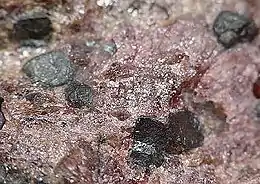Sonolite
Sonolite is a mineral with formula Mn9(SiO4)4(OH,F)2. The mineral was discovered in 1960 in the Sono mine in Kyoto Prefecture, Japan. In 1963, it was identified as a new mineral and named after the Sono mine.
| Sonolite | |
|---|---|
 Sonolite (in bottom left corner) with zincite and manganosite | |
| General | |
| Category | Silicate minerals |
| Formula (repeating unit) | Mn9(SiO4)4(OH,F)2 |
| Strunz classification | 9.AF.55 |
| Dana classification | 52.3.2d.3 |
| Crystal system | Monoclinic |
| Crystal class | Prismatic (2/m) (same H-M symbol) |
| Space group | P21/b[1] |
| Unit cell | a = 4.87 Å, b = 10.66 Å c = 14.28 Å β = 100.3°, Z = 2[1] |
| Identification | |
| Color | Red-orange, pinkish brown to dark brown Colorless in thin section[1] |
| Twinning | Common, singular or lamellar on {101}[1] |
| Mohs scale hardness | 5.5 |
| Luster | Vitreous, Dull |
| Diaphaneity | Transparent to translucent[2] |
| Density | 3.82–4.00 (measured)[1] |
| Optical properties | Biaxial (-) |
| Refractive index | nα = 1.765 nβ = 1.778 nγ = 1.787 |
| Birefringence | δ = 0.022 |
| 2V angle | 75° to 82° (measured) |
| Dispersion | r > v[1] |
| References | [3] |
Description
Sonolite is transparent to translucent[2] and is red-orange, pinkish brown to dark brown in color and colorless in thin sections. The mineral has a granular habit or occurs as prismatic to anhedral crystals up to 2.5 cm (0.98 in).[1] Sonolite is the manganese analogue of clinohumite,[4] a dimorph of jerrygibbsite,[1] and a member of the humite group.[3]
The mineral occurs in metamorphosed manganese-rich deposits. Sonolite has been found in association with calcite, chlorite, franklinite, galaxite, manganosite, pyrochroite, rhodochrosite, tephroite, willemite, and zincite.[1]
History
In 1960, Mayumi Yoshinaga was investigating alleghanyite and other manganese orthosilicates in Japan. He discovered a dull, red-brown mineral on the first level ore body of the Sono Mine, and later from a number of other sites.[4] Using samples from ten locations in Japan and one in Taiwan, the mineral was described in 1963 and identified as a new mineral species.[5] It was named sonolite after the mine in which it was first found and the name was approved by the International Mineralogical Association.[3][4]
Distribution
As of 2012, sonolite has been found in Austria, France, Japan, Kyrgyzstan, Romania, Russia, Sweden, Switzerland, Taiwan, and the United States.[3] The type material is held at Harvard University in Cambridge, Massachusetts, US.[1]
References
- "Sonolite" (PDF). Handbook of Mineralogy. Mineral Data Publishing. Retrieved June 20, 2012.
- "Sonolite". Webmineral. Retrieved June 20, 2012.
- "Sonolite". Mindat. Retrieved June 20, 2012.
- Yoshinaga 1963, p. 1.
- Yoshinaga 1963, pp. 1–2.
Bibliography
- Yoshinaga, Mayumi (January 25, 1963). "Sonolite, a New Manganese Silicate Mineral" (PDF). Memoirs of the Faculty of Science, Kyushu University. 14 (1): 1–21. Retrieved June 20, 2012.CS1 maint: ref=harv (link)
Further reading
- Cook, David (September–October 1969). "Sonolite, Alleghanyite and Leucophoenicite from New Jersey" (PDF). American Mineralogist. 54 (9 & 10): 1392–1398.
External links
![]() Media related to Sonolite at Wikimedia Commons
Media related to Sonolite at Wikimedia Commons